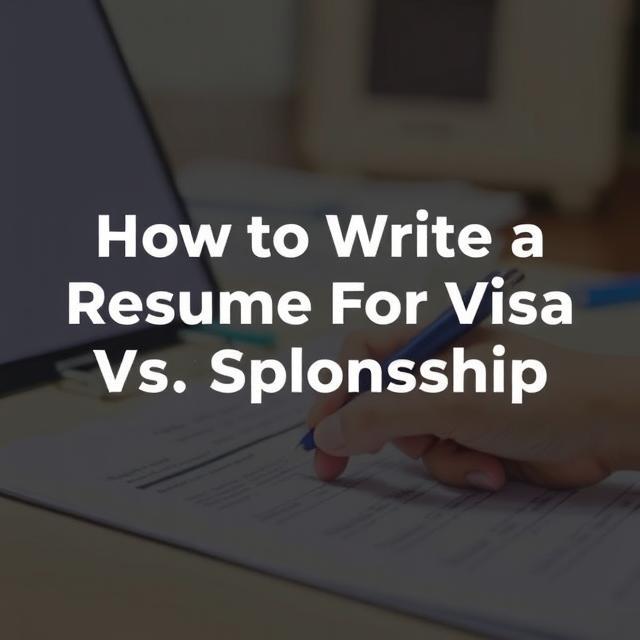Applying for a visa sponsorship job in the USA can be a complex and detailed process. However, breaking it down into clear steps can help you navigate it more smoothly. Here’s a step-by-step guide to applying for a visa sponsorship job:
Step 1: Research and Identify Job Opportunities
- Target Companies: Focus on companies that are known to sponsor work visas (such as large tech firms or international corporations). Research those companies and their job openings regularly.
- Check Visa Sponsorship Availability: Make sure that the job you’re applying for is eligible for visa sponsorship. Many employers specify if they offer visa sponsorship in the job listing.
- Job Boards: Use job search platforms like LinkedIn, Glassdoor, and Indeed, which allow you to filter for jobs offering visa sponsorship.
- Industry-Specific Websites: For specialized roles (e.g., tech, healthcare, or engineering), check industry-specific job boards where companies often post openings for international candidates.
Step 2: Prepare Your Documents
Before you apply, gather all the necessary documents that will be required throughout the application and visa process:
- Resume/CV: Tailor it to highlight your relevant skills, experience, and qualifications. For visa sponsorship roles, emphasize your specialized skills that justify the need for a work visa (e.g., a specialized degree or unique technical expertise).
- Cover Letter: Write a cover letter that highlights your interest in the company and why you would be a valuable asset, emphasizing that you are open to visa sponsorship.
- Academic Transcripts & Degrees: Prepare copies of your educational qualifications. If required, provide a credential evaluation if your degree is from a non-U.S. institution.
- References/Recommendation Letters: Have letters of recommendation or references from previous employers or professors that vouch for your skills and work ethic.
Step 3: Apply to Jobs
- Submit Applications: Apply to jobs that offer visa sponsorship. Pay attention to the deadlines, especially if the company is sponsoring visas with specific deadlines (e.g., H-1B).
- Tailor Your Application: Customize your resume and cover letter for each position. Focus on how your experience aligns with the role’s responsibilities and the company’s needs.
- Follow Up: After submitting your application, follow up with the hiring manager or recruiter if possible. Express your continued interest and availability for interviews.
Step 4: Prepare for Interviews
If your application is successful, you will be invited to interview with the company. Here’s how to prepare:
- Research the Company: Understand the company’s culture, products/services, and any recent news. Be prepared to explain why you want to work there.
- Explain Your Visa Status: During the interview, be ready to discuss your visa situation, including your current status (if you’re already in the U.S.) and your need for visa sponsorship. Be transparent about your eligibility for a work visa and the steps required.
- Highlight Your Skills: Focus on how your expertise can benefit the company. If your skills are in high demand (e.g., data science, engineering, or IT), emphasize this to show that you are a competitive candidate for visa sponsorship.
Step 5: Get an Offer
If you successfully pass the interview stage, the company may offer you a job. At this point, you’ll move forward with the visa sponsorship process:
- Negotiate Offer Details: Discuss salary, benefits, and any other relevant details. In some cases, it’s worth consulting with an immigration attorney to understand your options before agreeing to any offer.
- Obtain an Offer Letter: The employer will send you an official offer letter or employment contract. This document is crucial for the visa application process.
Step 6: Employer Files a Petition
After you accept the job offer, the employer will begin the visa sponsorship process:
- H-1B Visa (if applicable): For specialized roles, the employer must file a Labor Condition Application (LCA) with the U.S. Department of Labor (DOL) to confirm that hiring you will not negatively impact U.S. workers. After that, they will file a Form I-129 petition with the U.S. Citizenship and Immigration Services (USCIS).
- L-1 Visa (if applicable): If you are transferring from a foreign branch of the company to a U.S. office, the employer will file an L-1 petition.
- O-1 Visa (if applicable): For extraordinary talent, the employer will file a petition with the necessary documentation proving your exceptional abilities.
Important Note: The employer will also be responsible for covering most of the costs associated with filing a work visa application.
Step 7: Visa Approval and Interview
If the petition is approved by USCIS, you will likely need to attend a visa interview at the nearest U.S. consulate or embassy (if you’re not already in the U.S.). Here’s what to do:
- Prepare for the Visa Interview: Bring the petition approval notice (Form I-797), passport, visa application forms (e.g., DS-160), visa fee receipts, and any other required documents.
- Attend the Interview: Answer questions regarding your job, qualifications, and visa situation truthfully. The consular officer will assess your eligibility for the visa.
Step 8: Receive Your Visa
If your visa application is approved, you will receive your visa and can travel to the U.S. to begin your employment. You may receive a visa sticker in your passport or a document that you must present to immigration officers when you arrive in the U.S.
Step 9: Start Your Job
Once you have your visa, you can start working in the U.S. Be sure to follow all visa conditions (e.g., working only for the sponsoring employer) and maintain your legal status.
Step 10: Maintain Visa Status and Work Permit
- Stay Compliant: While working in the U.S., make sure you stay compliant with visa regulations, such as working only in the specified role and for the sponsoring employer.
- Renew Your Visa: Work visas such as the H-1B are usually valid for 3 years and can be extended. Keep track of your visa expiration date, and consult with your employer or an immigration attorney about renewing or changing your status if needed.






